Exploring the Souk Culture in the UAE
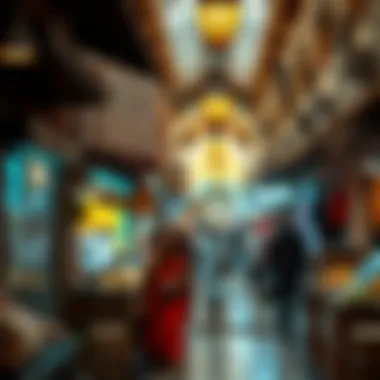
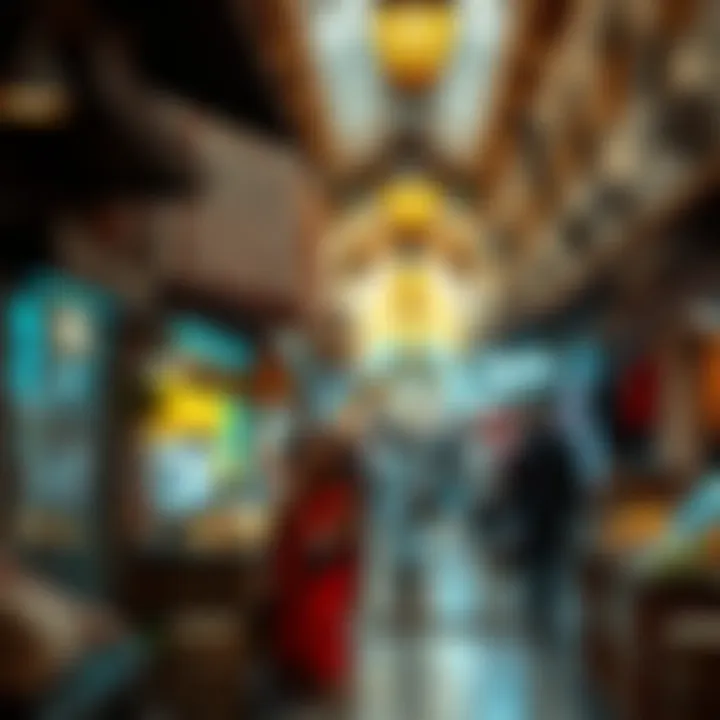
Intro
The souk culture in the United Arab Emirates stands as a proud testament to the country's history and socio-economic evolution. These marketplaces, bustling with life and brimming with unique products, offer a glimpse into the UAE's deep-rooted traditions. They’re not merely places to shop but represent a living narrative of the region's identity, culture, and trade. As cities like Dubai and Abu Dhabi have rapidly transformed, the souks retain a sense of nostalgia while adapting to modern times.
Souks are varied in character and offering. From traditional spices and textiles to contemporary art and crafts, each souk tells a different story. Visitors and locals alike experience an enchanting blend of sounds, smells, and colors, immersing themselves in the essence of Emirati life. Such shops often foster a community spirit, inviting interaction and a warm exchange among merchants and customers.
In this article, we will dive deep into the function and significance of the souks in the modern era. We will explore their historical roots, the significance they hold within the community, and analyze the changing market dynamics. By understanding these facets, one can appreciate how souks balance tradition with innovation, creating an enduring allure amidst modernization.
The Historical Context of Souks in the UAE
The souks of the United Arab Emirates (UAE) serve as not just markets but repositories of history, culture, and social interactions, deeply rooted in the fabric of Emirati life. Understanding the historical context of souks helps illuminate their enduring relevance in a world that's rapidly changing. These bustling centers offer more than just goods; they provide an insight into the traditions and practices that define the region.
Origin and Evolution
Historically, souks emerged as essential trading hubs in the pre-oil era, a time when the region's economy relied heavily on pearling, spice trading, and nomadic pastoralism. The earliest souks were modest setups in towns like Dubai and Abu Dhabi, where traders would gather to exchange goods and services.
In fact, many souks began as open-air markets, a place where merchants, often from diverse backgrounds, set up stalls adorned with colorful textiles and aromatic spices. Over time, these markets evolved into structured establishments with stalls and shops, adapting to the growing population and shifts in commerce.
- Key Influences on Evolution:
- Trade Routes: The UAE's strategic location made it a crucial stop on trade routes linking Asia, Africa, and Europe.
- Cultural Exchange: Interactions with traders and visitors from diverse places enriched the souks, introducing new products and practices.
- Economic Shifts: The discovery of oil in the mid-20th century prompted advances in infrastructure, subsequently transforming and expanding souk layouts to accommodate modern commerce.
These factors combined forged a unique atmosphere, melding ancient traditions with the demands of contemporary trade. The changes over time did not erase heritage; instead, the souks adapted, allowing them to persist as a central cultural landmark even in a modernizing UAE.
Cultural Significance
Souks are vital not only as marketplaces but also as cultural gathering places, reflecting the spirit of community and connection. They foster social interactions, allowing locals and visitors alike to engage in conversation and share stories. In these markets, the essence of Emirati hospitality shines through, as shopkeepers often greet patrons with a warm ‘ahlan wa sahlan’ (welcome).
The cultural significance of souks can be understood through several key aspects:
- Social Cohesion: Souks form a hub for local interactions, reinforcing a sense of belonging among residents.
- Cultural Heritage: They embody the traditions of craftsmanship, where artisans handcraft goods like textiles, pottery, and jewelry, providing insight into local craftsmanship that has been passed down through generations.
- Economic Education: For younger generations, souks are educational spaces, where families teach children about the value of goods, the act of bargaining, and the importance of supporting local trades.
"The souks are the heartbeat of the community, reminding us that every transaction is laced with stories and traditions."
This cultural foundation emphasizes that souks are more than just shopping destinations; they are living museums of history, where the past and the future converge. As the UAE continues to evolve, these markets keep the spirit of the region alive, serving as bridges between tradition and modernity.
Key Types of Souks in the UAE
Understanding the various souks across the UAE is essential to grasping the larger narrative of its vibrant culture. These marketplaces are more than just a place to shop; they are historical and social hubs, where the past seamlessly intersects with modernity. Each souk offers a unique experience, reflecting the diverse tapestry of the Emirates’ community and economy. Whether you're an investor seeking to explore property surrounding these areas or a local homeowner wanting to understand your neighborhood better, recognizing the distinct character of traditional markets, modern souks, and specialized markets is key.
Traditional Markets
Traditional souks serve as the backbone of the UAE's retail culture, deeply rooted in hundreds of years of history. Once the primary shopping destination for locals and travelers alike, these markets are typically characterized by their narrow alleys, bustling sounds, and vibrant displays of goods. Visit the Deira Souk in Dubai, and you're likely to be greeted with the fragrance of spices wafting through the air and the sight of colorful textiles piled high. The atmosphere is noisy but joyous, filled with haggling voices as shoppers strike deals.
Some prominent features of traditional markets include:
- Cultural Heritage: These souks are a reflection of the UAE's rich history and cultural identity, often showcasing handicrafts and traditional items that represent the region.
- Sense of Community: They act as gathering places for residents, fostering relationships and exchanges that are vital to local culture.
- Craftsmanship: Many traditional souks feature artisans demonstrating their crafts, from weaving to silver-smithing, keeping age-old skills alive among younger generations.
Modern Souks
In stark contrast to their traditional counterparts, modern souks in the UAE are often characterized by sleek architecture and a wide variety of high-end goods. The Souk Al Bahar in Dubai stands as a shining example, offering a blend of shopping and dining experiences with stunning views of the Burj Khalifa. These souks cater to a more affluent clientele, appealing to both locals and international tourists.
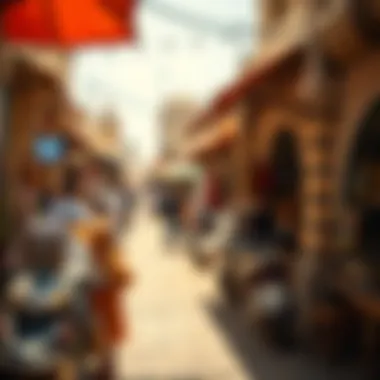
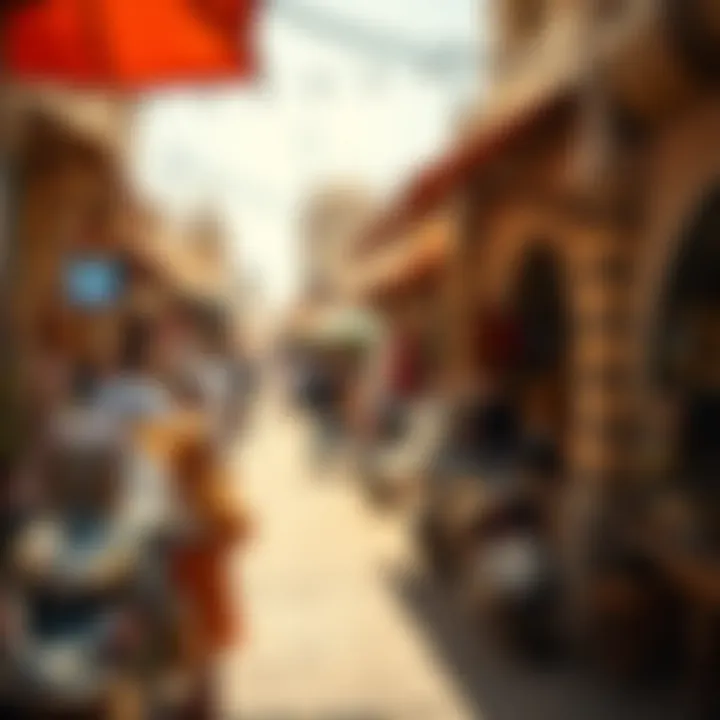
Key characteristics include:
- High-End Retail: Fashion brands, upscale jewelry, and gourmet dining establishments dominate the landscape, making these souks an attractive destination for luxury shopping.
- Entertainment Options: Many modern souks incorporate entertainment elements like live performances, art exhibits, or cinema, creating a comprehensive leisure experience.
- Ease of Access: Typically designed to be more accessible, these markets offer better parking facilities and public transport connections, encouraging higher foot traffic.
Specialized Markets
Some souks focus on specific goods, offering a more distinctive shopping experience. For instance, the Gold Souk in Dubai is renowned for its abundance of gold jewelry, with shops displaying intricate designs that draw visitors from around the world. Specialized markets allow consumers to engage deeply with specific products, gaining insights from shop owners who often have a wealth of knowledge about their crafts.
Notable features of specialized markets include:
- Expertise: Vendors in specialized markets often have years of experience and are passionate about their products, such as traditional textiles or spices.
- Focused Community: These markets attract niche clientele, fostering communities around shared interests and preferences.
- Unique Offerings: From organic spices at the Al Ain Souk to handcrafted ceramics at the Sharjah Souk, the specialized markets underscore the diversity of the local economy in the UAE.
"Souks are not just about shopping; they're a narrative of our history and a reflection of our present.
The Architectural Features of Souks
The souks of the UAE are not merely marketplaces; they are embodiments of culture and tradition, with architectural features that reflect the essence of Emirati heritage. Understanding these architectural aspects reveals how the souks have been designed to facilitate commerce while accommodating the social dynamics of the region. By exploring both the traditional design elements and the adaptive measures taken to meet modern needs, one gains insight into how these spaces contribute to the social fabric of Emirati life.
Traditional Design Elements
Traditional souks exhibit a unique architectural style that is distinctly tied to the local culture and climate. These structures often feature narrow, winding paths that create a labyrinth-like atmosphere, enhancing the sense of discovery as visitors explore. Built primarily of coral stone and mud, these materials not only reflect the historical context of their construction but also offer natural cooling, which is vital in the UAE’s hot climate. High ceilings and open-air designs allow for airflow, making an otherwise scorching experience more bearable.
Moreover, the use of mashrabiya screens—a traditional wooden latticework—adds both beauty and functionality, allowing light to filter through while ensuring privacy. This design element is a perfect reflection of the region's architectural sensibilities, marrying aesthetics with practicality. The vibrant colors and patterns found in the textiles and goods displayed within these souks are framed against the neutral tones of their surroundings, making each marketplace a feast for the eyes.
"In the shade of these traditional structures, a rich tapestry of dialogue, exchange, and cultural representation unfolds, highlighting the importance of community in these bustling centers."
Adaptations to Modern Needs
As the UAE continues to evolve in the face of globalization, many souks have begun to adapt to modern needs while still honoring their rich history. While maintaining traditional design elements, newer souks integrate modern conveniences, such as climate control systems and enhanced lighting, to cater to tourists and locals alike. These adaptations ensure that the souks remain relevant in a rapidly changing economic landscape.
For example, in areas where the foot traffic is high, several souks have expanded into multi-level buildings, allowing for more vendors and a wider selection of goods. Such developments have significantly improved the overall shopping experience, giving people easier access to everything from spices to textiles.
Additionally, technology is now playing a role in the evolution of the souk. Many merchants have embraced digital payment systems, a significant shift from traditional barter, which reflects the interplay between old and new market dynamics. With these modern elements, the souks have become not just shopping centers but vibrant hubs of cultural exchange, where the past and present coalesce seamlessly.
Economic Impact of Souks
Exploring the economic impact of souks in the UAE unveils a fascinating interplay between tradition and modernity. These vibrant markets are not merely places for commerce but act as vital hubs that contribute significantly to local economies. In a region where skyscrapers are the norm and malls abound, the soulful essence of souks brings unique economic value, enriching social and cultural landscapes.
Contribution to Local Economies
Souks stimulate local economies in ways that extend far beyond the transaction of goods. They create a ripple effect, generating employment opportunities and fostering entrepreneurship among local merchants. Here are some key elements of their contribution:
- Job Creation: Souks provide jobs for various groups, including shopkeepers, artisans, and service workers. Family-owned businesses, in particular, thrive in these markets, embodying a spirit of local entrepreneurship.
- Support for Local Artisans: Many products sold in souks, like textiles, spices, and handicrafts, are often made by local artisans. This not only preserves traditional crafts but also promotes the economic sustainability of these local producers.
- Boosting Ancillary Industries: Souks contribute to the growth of nearby businesses like restaurants, cafés, and hotels, benefitting from the foot traffic that souks attract. This interconnectedness enhances overall revenue in the vicinity, transforming neighborhoods into bustling economic districts.
- Cultural Events and Festivals: Many souks host cultural events, attracting both locals and tourists. These gatherings boost sales, showcasing local foods and crafts, further embedding the souks into the community’s cultural fabric while economically benefiting participating vendors.
Tourism and Souks
Tourism forms a substantial portion of the economic impact of souks. As visitors from around the globe flock to the UAE, souks present an authentic cultural experience that tourist traps often lack. In fact, exploring a souk can be as much about the experience as it is about the purchases. Here are some aspects worth noting:
- Unique Shopping Experience: Tourists often seek something authentic, and souks provide a contrasting experience to polished malls. The aroma of spices, the vibrant colors of textiles, and the lively chatter of vendors create a sensory overload that enchants visitors.
- Attraction of International Visitors: Some souks, like the Gold Souk in Dubai, have become iconic, drawing international attention. Tourists often visit these locations, eager to purchase unique items while experiencing local traditions firsthand.
- Food Tourism: Souks also cater to culinary explorations. Many tourists seek local cuisines, and souks often feature eateries that offer traditional dishes and snacks, enhancing their overall experience.
"Visiting a souk is not just about shopping; it’s about stepping into a world where the past and present blend seamlessly."
In summary, the impact of tourism on souks in the UAE cannot be underestimated. By drawing visitors and contributing to the local economy, these markets are more than just places for trade; they are gateways to the rich tapestry of Emirati culture.
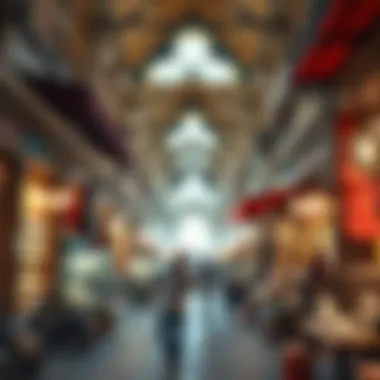
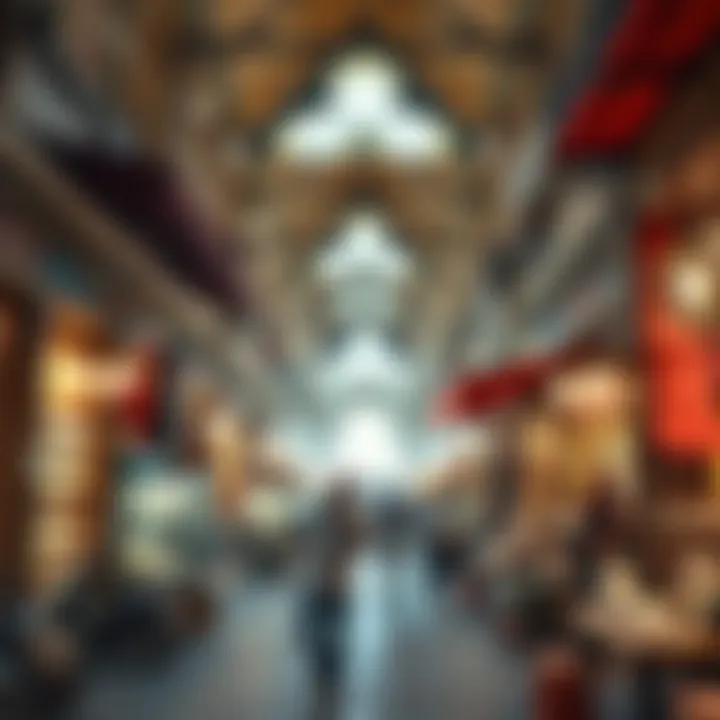
Cultural Exchange at Souks
Souks have always been more than just marketplaces; they serve as vibrant crossroads where diverse cultures converge. Within the context of the UAE, this cultural exchange becomes ever more significant, reflecting the nation’s rich tapestry woven from traditions both local and foreign. The souks present an opportunity not only to trade goods but to share stories, customs, and ways of life. Understanding the dynamics of such interactions enriches one's appreciation of both the marketplace and the people who inhabit it.
Interactions Between Locals and Tourists
When wandering through the souk, one can usually spot a delightful mix of locals and tourists. This combination offers a unique melting pot of ideas, influences, and narratives. Locals share anecdotes about their families and their heritage, often inviting visitors into the conversation.
- Language Exchange: It isn’t uncommon to hear snippets of Arabic mingling with various languages. Such linguistic interactions can spark deeper understanding. For instance, a simple exchange of pleasantries, "Marhaba!" (Hello) can lead to sharing experiences about food, festivals, and family traditions.
- Market Dynamics: Tourists observe the hustle and bustle, while locals navigate familiar pathways. Tourists might seek out traditional products, like spices or textiles, hoping to capture a piece of the Emirati experience, while locals may simply be doing their daily shopping. This blend creates a kind of economic and social rhythm unique to souks.
"If you can converse with a local vendor, you gather not just items, but narratives that breathe life into your purchases."
Role of Souks in Preserving Heritage
Sorry for any misunderstandings; the very existence of souks acts as a guardian of cultural heritage in the UAE. They embody the history and traditions preserved through generations, standing as a testament to the region’s identity.
- Cultural Artifacts: Many souks offer handcrafted goods that represent local craftsmanship. Whether it's intricately woven carpets or delicate jewelry, these items carry histories—stories of artisans and their ancestral skills.
- Customs and Traditions: Festivals often thread through the souk environment, where traditional events like the Eid celebrations transform the atmosphere. Locals deck out the marketplaces with decorations, while tourists, intrigued by the festivities, participate, learning about customs firsthand.
- Education Through Engagement: The interplay of old and new within the souks serves as an educational platform. Workshops on traditional crafts may be organized, allowing participants to experience and learn about practices that are at risk of fading away.
Through these interactions, it becomes evident that souks are not merely commercial spaces; they are the heart and soul of cultural exchange. This unique interplay not only preserves unique Emirati traditions but also fosters mutual respect and understanding with visitors, creating lasting memories and connections that transcend borders.
Souks and Contemporary Real Estate
The relationship between souks and contemporary real estate in the UAE reflects a fascinating dichotomy of tradition and modernity. As the skyline of cities like Dubai rises with futuristic architecture, souks remain steadfast emblems of the cultural heritage, embodying a blend of commerce, community, and cultural exchange that is difficult to replicate in modern malls. This section delves into how souks integrate within the fabric of contemporary developments, and how their unique essence impacts property values in the region.
Integration with Modern Developments
Souks are not just places for trade; they serve as vibrant social hubs. In recent years, many new real estate projects have recognized the significance of integrating souk-inspired designs into their developments. For instance, the Dubai Creek Harbour Real Estate project showcases a promenade lined with a blend of traditional and contemporary souk styles, allowing residents and tourists to engage in an authentic shopping and cultural experience while living in high-rise apartments.
By incorporating traditional elements such as narrow passageways and distinct architecture, modern developments create an appeal that draws both locals and expats. This integration doesn’t merely enhance aesthetic value; it also fosters community interaction, which is often lost in large shopping malls. Furthermore, projects that maintain a connection to the souk tradition can leverage the cultural significance to their benefit, attracting buyers interested in an authentic way of life that is linked to the UAE's rich heritage.
- Examples of integration include:
- Heritage-inspired design: Blending old-world charm with modern amenities.
- Social spaces: Incorporating community gathering spots similar to souks, enabling people to forge connections.
- Mixed-use developments: Utilizing commercial and residential spaces to create self-sufficient neighborhoods.
Impact on Property Values
Property values in the UAE are intricately tied to the charm and cultural significance of the regions' souks. Developments that are near or incorporate traditional souks often see an uptick in demand. Buyers are increasingly looking for not just a home but a lifestyle that includes access to local culture and history. Thus, properties that are sensitively integrated with souk culture tend to retain higher values.
Moreover, neighborhoods that cultivate this blend of modernity and tradition can experience an increase in foot traffic, bringing businesses and driving rental prices further up. Investors recognize that areas anchored in tradition often offer greater stability in property values, as these communities are less likely to be affected by transient trends.
"Locations near traditional souks have shown a resilience in property values, providing investors with a dual sense of cultural connection and financial security."
In summary, as the UAE continues to grow and modernize, the intrinsic value of souks in shaping contemporary real estate cannot be understated. They provide not just commerce but a network of community and culture that resonates deeply, enhancing the appeal and value of surrounding properties. This narrative reveals a future where souks coexist harmoniously with high-rise buildings, creating a unique lifestyle that caters to both tradition and modernity.
Experiencing a Souk: A Practical Guide
Experiencing a souk is akin to stepping into a living museum, a vibrant testament to the soul of the UAE. It’s not just about products; it’s about stories and connections. Every stall you pass buzzes with energy, as vendors and customers engage in a dance of commerce seasoned with cultural nuances. Visitors often find themselves enveloped in the aroma of spices and the vivid colors of textiles, providing a sensory experience like no other. Just navigating through these bustling avenues seems to hold both challenge and thrill, inviting you to learn while appreciating a rich heritage.
Navigating the Market
When you approach a souk, the wide array of sights and sounds may feel overwhelming. However, a good navigational strategy can enhance your experience significantly. Remember, each souk carries its unique charm. For instance, the gold souk in Dubai is filled to the brim with gleaming gold jewelry, whereas the spice souk will draw you in with its fragrant aroma.
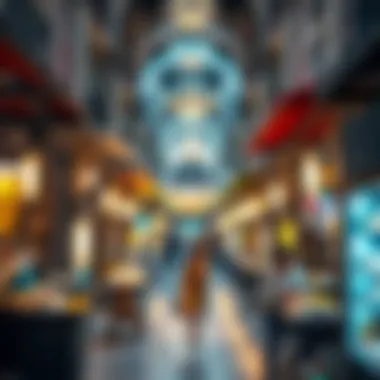
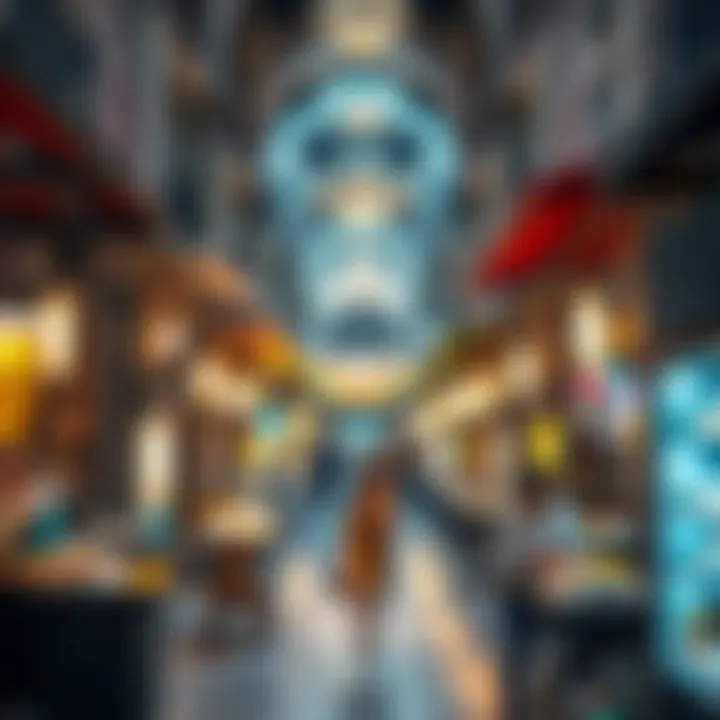
- Familiarize yourself with the layout: Spend a few minutes understanding the general layout. Often, you’ll find traditional and modern sections intermixed, but many souks will group vendors by the product they sell.
- Keep your valuables secure: While most visitors find that souks are safe, it’s still wise to keep personal belongings close. Pickpockets can find opportunities in crowded spaces.
- Ask locals for recommendations: Engaging with the vendors or patrons can lead to unexpected finds or lower prices. Locals appreciate curiosity about their culture, and many might share insights that enhance your experience.
Understanding Bargaining Culture
Bargaining is an integral part of the souk experience, not just a means to get a better deal but also a socially engaging activity. Here, negotiation is almost an art form, steeped in tradition and practiced with finesse.
- Start lower than your budget: When offered the initial price, counter with a lower figure. This is expected and often part of the game.
- Be polite and smile: Genuine friendliness can go a long way. Your approach can significantly affect the negotiation.
- Know when to walk away: If negotiations stall or become uncomfortable, expressing disinterest and moving on can sometimes lead the seller to reconsider and offer a better deal.
- Understand the product’s value: Having background knowledge about the items can empower you during negotiations, helping you distinguish good quality from overpricing.
In essence, traversing through a souk is more than a shopping trip; it’s an immersion into the UAE's identity. Each step in the market brings new interactions and excitement, along with the opportunity to better understand the cultural fabric of the region.
"Souks are not merely shopping locales; they are the heartbeat of local culture, a space where history and modernity meet in a vibrant interplay."
To better prepare yourself for this unique experience, you may want to explore further on Wikipedia or visit local tourism sites like Visit Dubai for practical tips and must-see destinations.
Challenges Facing Souks Today
The souk culture in the UAE, while rich in history and cultural significance, faces a set of hurdles that could affect its future appeal and function. These challenges primarily arise from the rapid modernization of urban areas, shifting consumer behaviors, and the evolving nature of competition in retail. Understanding these obstacles is crucial for stakeholders like investors, realtors, and expatriates who appreciate the value of preserving this unique aspect of Emirati identity amid increasing commercialization.
Competition with Malls
The rise of large shopping malls, such as The Dubai Mall and Mall of the Emirates, presents a formidable challenge to traditional souks. These modern retail spaces offer a vast array of brands and amenities — from air conditioning to entertainment options — creating a comfortable shopping environment that attracts both locals and tourists.
- Accessibility: Malls are often situated in prime locations, making them easy to access.
- Convenience: Shoppers can find a variety of products in one location, reducing the need to wander through multiple stalls.
- Diverse Amenities: With food courts, children's play areas, and leisure activities, malls provide a full-day outing experience.
This fierce competition has led many souks to adapt their offerings, but the challenge lies in maintaining their authentic charm while trying to cater to modern consumers’ expectations.
"The survival of traditional souks hinges on their ability to innovate without losing their cultural essence."
Preservation vs. Modernization
The tension between preserving the soul of traditional souks and adapting to a rapidly changing economic landscape is palpable. On one hand, there is a strong push for modernization.
- Technology Integration: Many souks have started adopting digital tools for payment and inventory management, streamlining operations.
- Marketing Strategies: Social media and online platforms are being utilized to market the offerings of souks, showcasing their unique products to a broader audience.
However, on the flip side, there are concerns about losing the very identity that makes these markets special. As souks embrace modern practices, they risk alienating the local clientele that values cultural authenticity.
- Authenticity in Offerings: Ensuring that goods sold resonate with local heritage or craftsmanship is crucial.
- Community Engagement: Souks must involve local artisans and merchants in their strategic changes to maintain heritage.
- Balancing Act: Striking a balance where modernization enhances rather than overshadows the cultural richness of the souk experience is essential
The Future of Souks in the UAE
The marketplace landscape in the UAE is at a crossroads, where tradition meets modernity. Souks, once the heartbeat of trading, now face an evolving environment influenced by rapid urbanization and shifting consumer preferences. The future of souks is paramount for those invested in real estate, local businesses, and cultural preservation, emphasizing the necessity to adapt while innovating.
Emerging Trends
In recent years, several noteworthy trends have begun to shape the future of souks across the UAE. First and foremost is the integration of technology into traditional setups. Many souks are experimenting with online platforms to extend their reach beyond local shoppers. For example, places like the Souk Al Markazi in Abu Dhabi have begun to host virtual tours, allowing customers not only in the UAE but globally to browse products.
The push towards eco-friendly and sustainable practices is also gaining momentum. Vendors are increasingly aware of their carbon footprints, leading to a rise in traditional products packaged in biodegradable materials. Furthermore, the promotion of local artisans supports the economy while enhancing cultural authenticity, making a trip to the souk more than just a shopping experience; it becomes a journey into the rich heritage of the region.
Another emerging trend is collaborative spaces where different vendors share areas, fostering a sense of community and collaboration. This arrangement enhances the shopping experience, offering customers a broader selection while allowing small businesses to thrive in a competitive environment. For instance, some souks now include cafes and art installations, creating a holistic atmosphere that encourages longer visits and more consumer engagement.
Sustaining the Souk Experience
To maintain the charm and relevance of souks, stakeholders must adopt strategies that not only enhance the marketplace's appeal but also respect its heritage. One effective approach is through culturally immersive experiences. Tourists and locals alike are drawn to activities like traditional cooking classes, handicraft workshops, and live cultural performances held within the souks. These experiences enrich visitors’ understanding of Emirati heritage, turning a simple market trip into an educational journey.
Moreover, to cement their place in the community, souks can benefit from strong branding and marketing efforts that communicate their unique selling points. By highlighting the advantages of shopping in a traditional souk—personalized service, one-of-a-kind products, and the opportunity to support local artisans—these markets can differentiate themselves from impersonal shopping malls.
> "Souks represent not just a place to shop but a vibrant experience that weaves our culture into everyday life. To lose them is to lose a part of our identity."
Adopting a flexible business model that can quickly pivot according to customer demands and preferences is also crucial. For instance, many souks are embracing seasonal themes or festivals to attract crowds at various times of the year, such as special markets during Ramadan or Eid, which highlight the cultural significance of these periods while encouraging community patronage.



